
The fourpence was issued on 1 May 1935, printed by De La Rue. The issued sheets contained 80 stamps in 8 rows of 10.
There were three frame plates: 1, 2A and 2B and several centre plates. Frame plate 1 is in the bottom margin under the second stamp while 2A and 2B are under the ninth stamp. The first centre plate was unnumbered while later plates were numbered 2, 3, 4 and 5. Centre plate numbers 2 and 3 are in the bottom margin under the second stamp while plates 4 and 5 are under the first. As a further complication, plate 4 was a double plate both of whose panes were numbered 4, but for which printings exist without the plate number showing or only being partially visible.
As frame plate numbers 2A and 2B appear at the right of the bottom margin while the centre plate numbers appear at the left, to show the combination of centre and frame plate numbers, a complete bottom marginal strip of 10 stamps is required. They are ideally collected in blocks of 20.

Distinguishing the frame plates


Strong line in lowest right leaf
in plate 1, weak in 2A and 2B
A major help in studying the plates is that stamps printed from frame plate 1 can be distinguished from those printed from frame plates 2A and 2B.
In plate 1, the central line in the lowest leaf in the design at the right is strong while in plates 2A and 2B it is weak indicating that some damage occurred in the transfer roller after plate 1 was laid down.
Plate 1 was re-introduced late in the life of the issue, but even in these late issues the line remains much stronger than it does in plates 2A and 2B.
I have not been able to find any reference to this difference in the frame plates in the literature prior to my article in The Kiwi [1]. If anyone knows of an earlier reference or of a means of distinguishing between the centre plates, I would be pleased to hear from them.
Unnumbered Centre Plate
A) The first issue was on 1 May 1935 on single watermarked paper perf 14, and was printed from the unnumbered centre plate and frame plate 1. It has a black vertical line (guide mark) in the margin below stamp 1.
B) It then appeared in August 1936 on multiple watermarked paper perf 14 x 13½, again printed from the unnumbered centre plate and frame plate 1. However, there is no black guide mark in the margin below stamp 1.
C) In 1938, it appeared on multiple watermarked paper perf 14 x 13½, printed from the unnumbered centre plate and either frame plate 2A or 2B. It has the black guide mark in the margin below stamp 1, but it is less clear than before.
D) In 1945, printings again appeared printed from the unnumbered centre plate and frame plate 1. It has a clear black guide mark in the margin below stamp 1. It was on coarse multiple watermarked paper perf 14 x 14½
The four situations are shown in the blocks below.
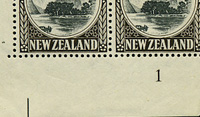
A) Frame plate 1
unnumbered centre plate
1935 single wmk
vertical line
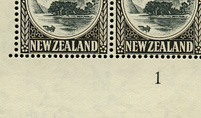
B) Frame plate 1
unnumbered centre plate
1936 multi wmk
no vertical line
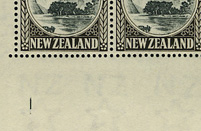
C) Frame plate 2A or 2B
unnumbered centre plate
1938 multi wmk
indistinct vertical line
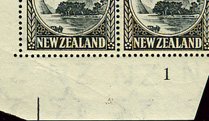
D) Frame plate 1
unnumbered centre plate
1945 multi wmk
vertical line
The question is what happened to the guide mark in the 1936 printing. It appears that the engraved line in the margin of the plate was filled in. When the 1938 printing was made, this 'filling' had partially come out and so the guide mark appears again, but rather indistinctly. The filling had then been cleared out by the time the 1945 printing was made and so it again appears clearly.
Perforation 14x13¾, Single Watermark, 1 May 1935
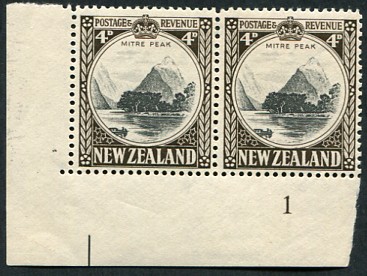
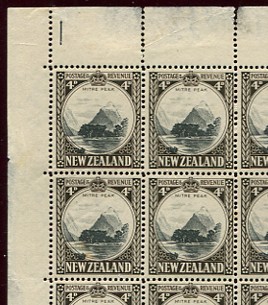
The first issue on 1 May 1935 was on fine single watermarked paper with a vertical mesh and was perf 14x13¾ although it is often described as perf 14.
Although it has a comb perforation, there is an overlap in the strikes giving it the appearance of a line perforation as can be seen in the block on the right.
It only exists in the combination of unnumbered centre plate and frame plate 1.
The black centre plate has vertical guidelines in the top and bottom margins.
Perforation 14 x 13½, Multiple Watermark, August 1936
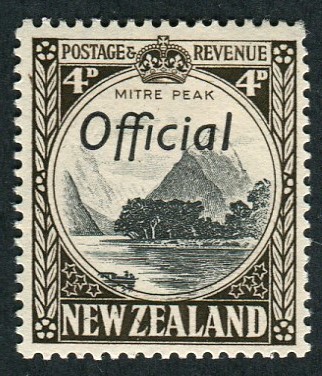
Unnumbered centre plate, frame plate 1

On August 1936, stamps were issued on fine multiple watermarked paper using the same plates as the 1935 issue, i.e. unnumbered centre plate and frame plate 1.
At the same time stamps were issued on fine multiple watermarked paper overprinted Official.
The stamp shown on the right is clearly from frame plate 1 as the central line in the lowest leaf in the design at the
right is strong (in plates 2A and 2B it is weak).
In fact, the 4d perf 14 x 13½ from frame plate 2A or 2B does not exist overprinted Official.
Unnumbered centre plate, frame plate 2A or 2B


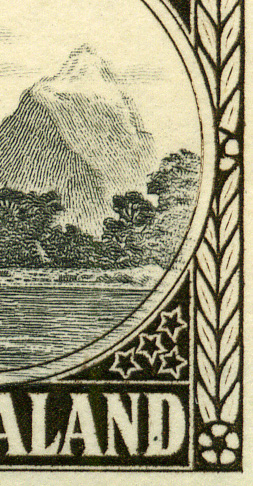
Normal and double re-entry on unnumbered centre plate and frame plate 2A or 2B.
According to the RPSNZ Handbook Vols 1 and 2, stamps were issued from the original centre plate in April 1938 in conjunction with a new frame plate 2A and, in August 1938, in conjunction with a new frame plate 2B.
The RPSNZ Handbook Vol 6 gives a different account and states that a second unnumbered centre plate was produced and that the original unnumbered centre plate was never used in combination with frame plates 2A and 2B.
They cite as evidence that the double re-entry in R3/8 never appears in combination with the new frame plates. However, the illustration on the right shows the double re-entry with a weak line in the lowest right leaf indicating that the frame plate is either 2A or 2B.
Further confirmation for the account given in Vols 1 and 2
is the appearance of the vertical black guide line in the margin below R8/1 showing
that it is from the unnumbered centre plate in conjunction with one of the frame plates 2A or 2B.
The account in Volume 6, therefore appears to be in error.
Centre plate 2, frame plate 2A or 2B
In April 1938, were issued from a new centre plate 2 in conjunction with the new frame plate 2A and in August 1938, in conjunction a new frame plate 2B. Centre plate 2 only exists perf 14 x 13½.

Line Perforation 14, Multiple Watermark, November 1941
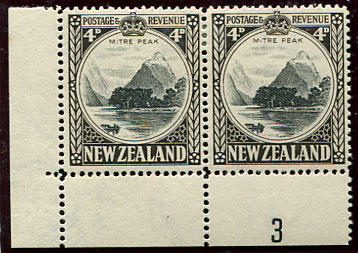
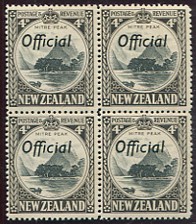
A new centre plate 3 was produced in 1940, but due to Blitz damage to De La Rue's premises, this plate along with frame plate 2B was passed to Waterlow. Early issues using centre plate 3 are therefore Blitz perforations.
In late 1940 a printing of 54,000 sheets was returned unperforated to De La Rue. Most of this printing was lost in the fire of December 1940 although 2000 sheets were saved and line perforated 14 by De La Rue. They were issued in November 1941 and are the rarest of the second pictorials as most of the small issue was overprinted Official.
A plate pair perf 14 and showing centre plate 3 and a block of 4 overprinted Official are shown.
In both the line perforations are clearly seen.
Line Perforation 12½, Multiple Watermark, August 1941
In February 1941 a further 51,000 sheets were ordered and they were both printed and line perforated 12½ by Waterlow using plates 3 and 2B. Thet are therefore also a Blitz perforation. Although they were printed after those line perf 14, they were issued earlier in August 1941.

Again, the majority of the printing was overprinted Official.

The line perf characteristics are clearly seen in these two plate strips.
Perforation 14 x 14½, Multiple Watermark, coarse paper, July 1942
Centre plate 3, frame plate 2A and 2B
The plates were returned to De La Rue and stamps from centre plate 3 in conjunction with both frame plates 2A and 2B and printed by De La Rue were issued in July 1942. They were on coarse paper and perf 14 x 14½ and that was the paper and perforation used for all the remaining issues.
Double centre plate 4, frame plate 2A and 2B
Sheets from a new centre plate 4 in conjunction with frame plates 2A and 2B were issued in April 1943. Vol 2 and Vol 6 give different accounts of plate 4. Recent evidence suggests that the true story contains elements from both earlier accounts.
According to Vol 2, in April 1943 stamps were issued from a double centre plate. The left hand pane was numbered 4, but the right hand pane was unnumbered. According to Vol 6, a new double plate was not produced. The unnumbered centre plate was the one that had been used in 1938 in combination with frame plates 2A and 2B and the number 4 was subsequently added to this plate.
Neither account fits the information given below.
The following two plate blocks of 20 are on coarse paper, perforated 14 x 14½. One has an unnumbered centre plate while the other is numbered 4.


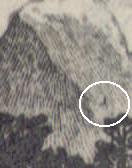
Vol 6 lists four constant flaws that exist in rows 7 and 8 of the new centre plate and they exist in both the unnumbered centre plate and from the plate numbered 4. The most prominent is a reversed L shaped flaw in position R8/5. The above two plate blocks both have all the flaws and both have a darker centre impression in position R8/3. There is therefore no doubt that printings exist with the flaws both showing an unnumbered centre plate and one with the number 4.
However, blocks also exist from an unnumbered centre plate and from a plate with number 4 which have none of the flaws [2].
The solution is shown by the following block which shows the flaws, but
has only part of the plate number 4 showing.
I have also seen blocks where the number 2B is only partly shown.

The only explanation, however unlikely, that fits the facts is that there was a double plate in which both panes always had the number 4. In some printings, the 4 was not printed (giving the "unnumbered" plates) while in others it only partially appears. Not being a printer, I am unable to explain the mechanism by which the number 4 does not appear as there is no albino impression in the margin that you might expect if it was just that part of the plate was not inked.
The 2d plate 5 is another example in this issue where two panes of a double plate both had the same number although in that case the letters A and B were later scratched on the plate.
In conclusion:
- The original unnumbered centre plate occurs in combination with frame plates 1, 2A and 2B on fine paper perf 14 x 13½ and with frame plate 1 on coarse paper perf 14 x 14½.
- Stamps from a double centre plate were issued in 1943. Both panes were numbered 4 and they occur in combination with frame plates 2A and 2B on coarse paper perf 14 x 14½.
- Printings exist from the double centre plate in which the number 4 is missing or only appears partially.
An article, based on the evidence given here, has been published [3].
Original frame plate 1 with original unnumbered centre plate and with centre plate 5
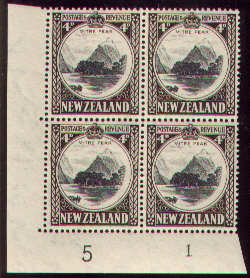
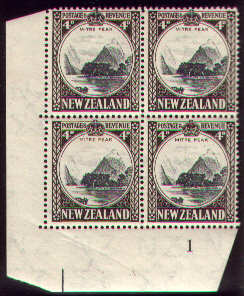
In March 1945, stamps were issued from the original frame plate 1 in combination both with the original unnumbered centre plate and with a new centre plate 5.
In the plate block from the unnumbered centre plate the black guide line is as clear as it was in the original 1935 issue.
The stamp was replaced by a GVI definitive on 1 May 1947.
Summary of plate numbers and perforations
The combination of plate numbers, perforations and watermarks are complex and are summarised below.Single wmk, perf 14
-
1 May 1935: Unnumbered centre plate, frame plate 1.
Multiple wmk, perf 14 x 13½
-
August 1936: Unnumbered centre plate, frame plate 1.
-
April 1938: Unnumbered centre plate, frame plate 2A.
-
August 1938: Unnumbered centre plate, frame plate 2B.
-
April 1938: Centre plate 2, frame plate 2A.
-
August 1938: Centre plate 2, frame plate 2B.
Multiple wmk, perf 12½ line
-
August 1941: Centre plate 3, frame plate 2B.
Multiple wmk, perf 14 line
-
November 1941: Centre plate 3, frame plate 2B.
Coarse paper, multiple wmk, perf 14x14½
-
July 1942: Centre plate 3, frame plate 2A or 2B.
-
April 1943: Double centre plate. Both halves exist both unnumbered and with plate 4. Frame plate 2A or 2B.
-
March 1945: Original unnumbered centre plate. Original frame plate 1.
-
March 1945: New centre plate 5. Original frame plate 1.
Background information on the 4d is taken from
The Postage Stamps of New Zealand Vols 1, 2, 4 and 6
published by the
Royal Philatelic Society of New Zealand in 1938, 1950, 1964
and 1977 respectively.
[1] Robert Clark, The Second Pictorials:
Problems with the Fourpence Plates, The Kiwi, vol 52, no 6,
pp 133-136, November 2003.
Published by
The New Zealand Society of Great Britain.
[2] Keith Collins, private communication 2003.
[3] Robert Clark, The Second Pictorials:
Problems with the 4d Plate 4 (revisited), The Kiwi,
vol 65, no 5, pp 144-147, September 2016.
All scans were made by the author.